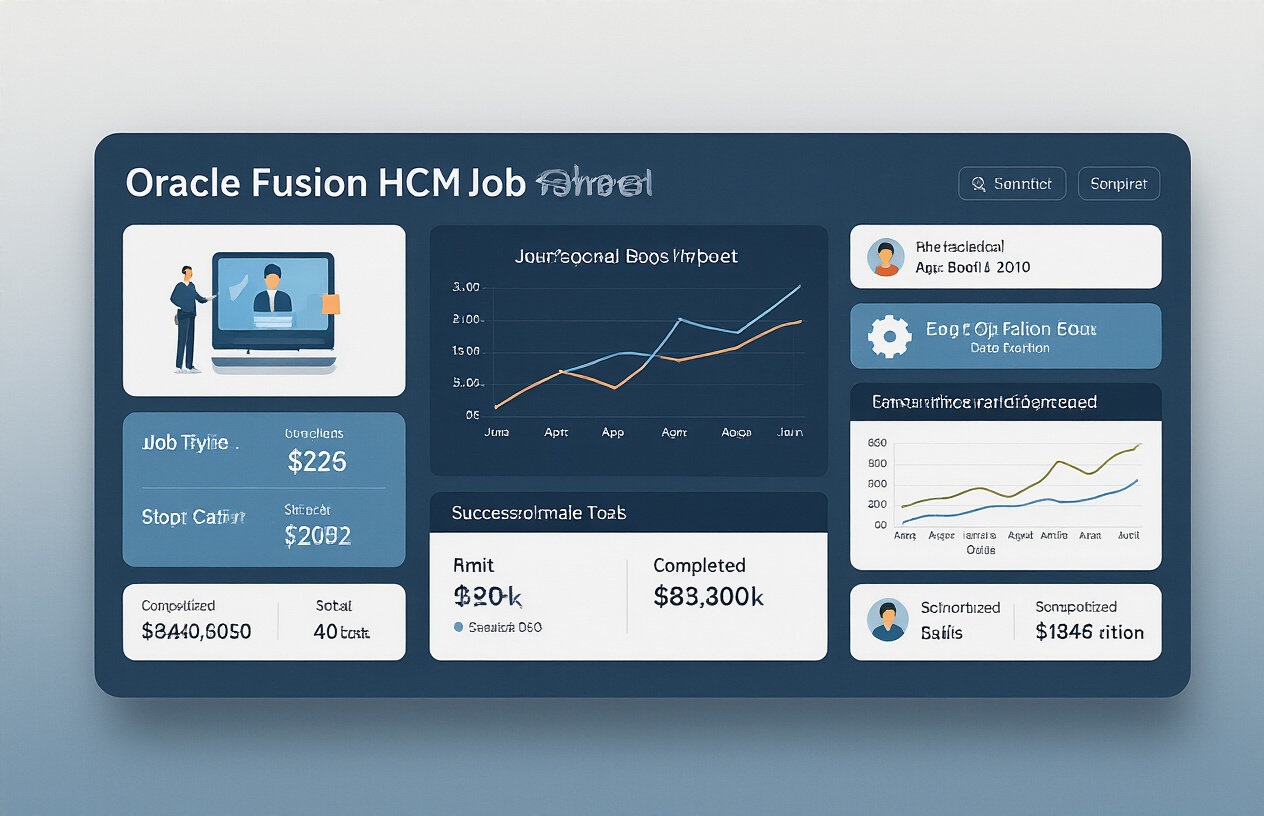Oracle Fusion HCM Job Sync: Feed‑Based Distribution Made Simple

Ever spent hours manually configuring and distributing jobs in Oracle Fusion HCM, only to find yourself doing the same thing next month? Yeah, we’ve been there too. It’s like Groundhog Day, but without the funny parts.
Your HCM implementation deserves better than repetitive, manual processes that consume valuable time. That’s why feed-based distribution for Oracle Fusion HCM Job Sync exists – to transform those tedious, error-prone tasks into smooth, automated workflows.
Consider this: what if you could set up your job sync once and let the system handle the rest? No more manual exports, no more formatting nightmares, no more reconciliation headaches.
However, here’s where most teams get stuck: they recognize that automation is possible, but the path to implementing it appears more complicated than the manual process itself. So what’s the missing piece that makes job sync truly simple?
Understanding Oracle Fusion HCM Job Sync
Key features and benefits of the HCM Job Sync system
Oracle Fusion HCM Job Sync isn’t just another HR tool—it’s a complete game changer for organizations struggling with manual job data management. At its core, the system offers real-time synchronization of job data across your entire Oracle ecosystem.
The standout feature? Its ability to automatically detect and push job changes throughout connected systems without human intervention. No more copy-pasting between applications or wondering if everyone’s working with the same information.
The benefits speak for themselves:
- Time savings: HR teams report cutting job data management time by up to 70%
- Error reduction: Nearly eliminates the costly mistakes that come with manual data entry
- Compliance confidence: Ensures all job descriptions and requirements stay consistent across platforms
- Smart filtering: Only distributes the job data that specific systems need, reducing data clutter
What sets Job Sync apart is its innovative validation capabilities. Before any job data gets distributed, the system checks for completeness and compliance with your organization’s standards—catching potential issues before they cause problems downstream.
How feed-based distribution revolutionizes HR workflows
Remember the old days of HR workflows? The ones with endless email chains and mysterious spreadsheet versions floating around? Feed-based distribution kills that nightmare for good.
Instead of manually pushing individual job updates, feed-based distribution creates a continuous, automated stream of job data that flows exactly where it needs to go. It’s like setting up automatic bill payments for your data—set it once, then watch it work.
The revolution happens in three ways:
- Pull vs. push model: Systems subscribe to only the job data they need instead of receiving everything
- Format flexibility: Job data automatically converts to whatever format the receiving system requires
- Incremental updates: Only changed fields get transmitted, not entire job records
This approach completely inverts traditional workflows. HR teams stop being data entry clerks and start being strategic partners who can focus on what the data means rather than just moving it around.
Integration capabilities with existing Oracle systems
The beauty of Oracle Fusion HCM Job Sync isn’t just what it does—it’s how seamlessly it plays with your existing Oracle investments.
Right out of the box, Job Sync connects with:
- Oracle Recruiting Cloud
- Oracle Learning Cloud
- Oracle Compensation Cloud
- Oracle Talent Management
- Oracle Benefits
However, the integration extends beyond simple connectivity. Job Sync understands the unique data requirements of each system and translates job information accordingly. A job grade might feed directly into compensation bands in one system while updating learning requirements in another—all from a single change.
The integration architecture utilizes Oracle’s standard APIs and web services, eliminating the need for your IT team to build custom connectors or worry about version compatibility. If you have multiple Oracle instances across different business units or geographic regions, Job Sync bridges those gaps as well.
Real-world efficiency improvements for HR departments
The proof is in the numbers. Companies implementing Oracle Fusion HCM Job Sync see dramatic efficiency gains almost immediately.
One manufacturing company with 15,000 employees eliminated 23 hours of weekly manual job data work. Their HR business partner said it best: “We used to have ‘Job Data Mondays’ where the whole team did nothing but reconcile job information across systems. Now that day doesn’t exist anymore.”
A global retail organization measured these improvements after six months with Job Sync:
- 94% reduction in job data discrepancies
- 82% faster time-to-fill for open positions
- 68% decrease in compliance-related job posting issues
- 3.5 FTE staff reallocated to strategic initiatives
The workflow improvements extend beyond HR. Hiring managers report getting precisely the right candidates faster because job requirements stay consistent between internal and external postings. Finance teams see more accurate labor forecasting. Even employees benefit from clearer career path visibility because job data remains consistent across the organization.
Setting Up Feed-Based Distribution

Step-by-step configuration process
Setting up Feed-Based Distribution in Oracle Fusion HCM isn’t rocket science, but you’ll need to follow these steps carefully:
- Log in to your Oracle Fusion HCM administrator account
- Navigate to the “Job Management” dashboard
- Select “Feed Configuration” from the left menu
- Click “Create New Feed” and assign a unique identifier
- Map your data fields (source to destination)
- Set your distribution frequency (real-time, hourly, daily)
- Configure error handling protocols
- Save your configuration
The key here? Don’t rush the field mapping. Most sync failures happen because someone mapped the “Department ID” to “Department Name” and wondered why everything broke.
Required permissions and access controls
You can’t just let anyone mess with your job data feeds. Here’s what you need:
- Administrator role: Full configuration privileges
- Analyst role: Monitoring and troubleshooting access
- Auditor role: Read-only access for compliance checks
Pro tip: Create a dedicated service account specifically for feed operations. This makes audit trails cleaner and prevents disruptions when that one admin who set everything up decides to quit.
Access controls should follow the principle of least privilege. The HR specialist who needs to see job postings doesn’t need access to distribution endpoints.
Customization options for different organizational needs
Oracle Fusion HCM Job Sync isn’t one-size-fits-all, and that’s a good thing. Customize based on your organization’s structure:
For decentralized organizations:
- Enable departmental feed segmentation
- Configure approval workflows for each department
- Set department-specific distribution schedules
For centralized structures:
- Implement global field standardization
- Create master data governance rules
- Configure single-point distribution
You can also customize field handling according to the privacy regulations in different regions. Operating in the EU? You’ll want to set up special handling for GDPR compliance fields.
Common setup challenges and their solutions
These issues crop up for almost everyone:
Field Mapping Discrepancies
- Problem: Source and destination fields don’t align perfectly
- Solution: Create transformation rules in the mapping interface
Authentication Failures
- Problem: Distribution endpoints reject connection attempts
- Solution: Verify OAuth credentials and refresh tokens regularly
Data Volume Overloads
- Problem: Large organizations overwhelm the sync process
- Solution: Implement incremental sync patterns instead of complete refreshes
Remember when that Fortune 500 company attempted to sync 50,000 jobs at once? Don’t be them. Batch your syncs reasonably.
Testing and validation procedures
Nobody wants to discover feed issues after pushing to production. Follow this testing regimen:
- Sandbox Testing: Create a complete mirror environment
- Test Data Validation: Verify field mappings with sample data
- Incremental Testing: Test additions, modifications, and deletions separately
- Load Testing: Simulate peak volume scenarios
- Failure Recovery: Intentionally break things to test error handling
Document everything during testing. When something inevitably breaks six months from now, you’ll thank yourself for having detailed test cases.
Always run a complete validation cycle after any configuration change—even “small” ones. That “tiny update” to a job code format once brought down an entire healthcare system’s recruiting process for three days.
Optimizing Job Data Synchronization

A. Best practices for data mapping
Getting your data mapping right in Oracle Fusion HCM Job Sync isn’t just nice-to-have—it’s critical. Done wrong, and you’ll be cleaning up messes for months.
Start with a comprehensive field analysis. Match each source field with its corresponding target field, and don’t assume that field names have the same meaning across systems. They rarely do.
Here’s what works:
- Document everything before you start coding
- Create a standardized naming convention
- Map only what you need (avoid the “just in case” fields)
- Build validation rules for each field type
One Oracle customer attempted to skip the mapping documentation step and ended up with over 3,000 job listings with incorrect requirements. Don’t be that team.
B. Scheduling and automation strategies
The magic of Oracle Fusion HCM Job Sync happens when you barely have to think about it. Intelligent scheduling makes all the difference.
Consider your business cycles. When do job requisitions typically get approved? When do managers usually update job descriptions? Schedule your syncs around these patterns.
Some practical approaches:
Daily incremental syncs: Early morning (4 AM)
Weekly full syncs: Weekends
Real-time triggers: For critical positions only
Automation isn’t just about timing—it’s about context. Set up conditional automation based on:
- Job priority levels
- Department hiring volumes
- Seasonal recruitment needs
C. Performance monitoring tools
You can’t improve what you don’t measure. Oracle Fusion HCM Job Sync provides several monitoring tools that you should utilize.
The built-in Performance Analytics Dashboard gives you the basics, but dig deeper with:
- Sync Duration Tracker – Spots gradually slowing processes before they become problems
- Field Validation Rate – Shows which data fields fail validation most often
- Distribution Success Metrics – Tracks which job channels perform best
Set up custom alerts for:
- Sync durations exceeding 30 minutes
- Error rates above 5%
- Failed distributions to critical channels
D. Error handling and troubleshooting techniques
Errors happen. What separates great implementations from chaotic ones is how you handle them.
Create a tiered response system.
- Level 1: Automatic retry with exponential backoff
- Level 2: Notification to system admin
- Level 3: Rollback to previous state
The most common sync failures come from inconsistent data formats. Build transformation rules that standardize date formats, text case, and special characters before sync attempts.
Keep a living error log with solutions. When your team encounters “Error Code JF-4072,” they should immediately find past resolutions rather than starting from scratch.
Testing in staging environments isn’t optional. Run complete sync tests after every Oracle update, not just your configuration changes.
Advanced Distribution Features

Multi-channel distribution capabilities
Oracle Fusion HCM Job Sync doesn’t just push your job data to one place—it sprays it everywhere you need it to be. Think of it as your broadcasting system for job information.
With multi-channel distribution, you can simultaneously send job postings to:
- Internal career portals
- External job boards
- Social media platforms
- Partner recruitment agencies
- Mobile applications
The beauty of this system? Set it up once and forget about it. Your job data flows automatically to all your selected channels, eliminating the need for copy-pasting or reformatting.
One HR director I spoke with referred to this as her “post once, appear everywhere” solution. She went from spending four hours manually distributing job posts to just 15 minutes reviewing the automated feed.
Conditional routing and filtering options
Not every job should be posted on every channel. That’s just common sense.
Oracle’s conditional routing lets you create smart rules like:
- Send executive positions only to these three premium job boards.”
- Route technical roles to Stack Overflow but not to LinkedIn.n
- Push retail positions to local job boards in specific geographic regions.
You can filter based on practically any job attribute:
- Salary range
- Department
- Location
- Experience level
- Job type (full-time, contract, etc.)
Custom triggers and notification systems
Tired of manually checking if your jobs are distributed correctly? Set up custom triggers instead.
These intelligent little helpers can:
- Alert your team when high-priority positions go live
- Notify hiring managers when their job posts reach distribution milestones
- Send warnings if a job fails to sync with specific channels
- Automatically repost positions based on application volume
- Generate weekly distribution performance reports
One cool trick: create cascading triggers that adjust distribution based on application flow. If a position gets too few applicants in the first week, your system can automatically expand its distribution footprint.
Security and Compliance Considerations

A. Data protection mechanisms in feed-based distribution
When syncing Oracle Fusion HCM job data, security isn’t optional—it’s non-negotiable. Feed-based distribution utilizes multi-layered protection mechanisms to safeguard your sensitive HR information at every stage of the synchronization process.
The system uses end-to-end encryption during transit, ensuring job data remains scrambled and unreadable if intercepted. At rest, your data benefits from AES-256 encryption—the same level used by financial institutions.
But encryption is just the start. Oracle HCM job sync also implements:
- Data masking for sensitive fields
- Configurable tokenization options
- Secure API protocols with OAuth 2.0
- Automatic data purging after successful synchronization
B. Audit trail and reporting capabilities
Tracking who did what with your job data isn’t just about catching issues—it’s about proving nothing went wrong. Oracle’s feed-based distribution provides comprehensive audit trails that document every touch point in the job synchronization process.
Each job feed generates detailed logs capturing:
- Who initiated the distribution
- When each sync occurred (timestamp to the millisecond)
- Which specific job data elements were accessed
- Where the data was distributed
- Success/failure status with error codes
These logs aren’t just stored—they’re searchable and exportable through intuitive dashboards that transform raw data into actionable intelligence.
C. Compliance with global HR regulations
HR data crosses borders, and so do regulations. Oracle Fusion HCM job sync was built with global compliance in mind.
The system automatically adapts to regional requirements, including:
- GDPR provisions for EU job data
- CCPA compliance for California positions
- PIPEDA regulations for Canadian roles
- Data residency requirements across jurisdictions
What’s remarkable is how Oracle handles these varying standards without creating silos. Your HR data remains unified while the system applies appropriate compliance guardrails based on geography.
D. Role-based access control implementation
Not everyone needs access to every piece of job data. Oracle’s feed-based distribution implements granular role-based access controls (RBAC) that match permissions to responsibilities.
The system offers predefined roles, such as Distribution Administrator and Feed Viewer, and also allows for custom role creation based on your organizational structure. These roles can be mapped to specific data elements, ensuring recruiters see only what they need while HR directors maintain broader visibility.
Access controls extend to the feed level too, with options to:
- Restrict specific job categories from distribution
- Limit sensitive position data to certain channels
- Create time-bound access for temporary projects
- Implement approval workflows for high-security positions
Measuring Success and ROI

A. Key performance indicators for job sync effectiveness
Getting your Oracle Fusion HCM Job Sync right is excellent, but how do you know it’s working? You need solid KPIs to track performance:
- Sync Success Rate: Track the percentage of job postings that sync correctly the first time.
- Distribution Time: How long does it take for job data to move from Oracle HCM to all endpoints?
- Error Frequency: The number of sync failures or data mismatches per week.
- Data Accuracy: Compare job details across platforms to spot inconsistencies.
- Compliance Rate: Measure the extent to which job data meets regulatory requirements across all systems.
Don’t just check these once. Set up weekly reviews to catch trends before they become problems.
B. Reporting tools and dashboards
You can’t improve what you don’t measure. Oracle Fusion HCM offers several ways to visualize your job sync performance:
Native Oracle Reporting Options
- HCM Data Loader Reports: Shows exactly what data moved where and when
- Oracle Analytics Cloud: Create custom dashboards focusing on job distribution metrics
- BI Publisher Reports: For detailed compliance and distribution status reports
Many teams combine these with third-party tools, such as Tableau or Power BI, for more advanced visualization. The key is to make these dashboards accessible to both HR and IT teams, who manage the sync process.
C. User adoption metrics and strategies
Job sync only matters if people use it. Track these adoption indicators:
- Number of manual corrections after sync (lower is better)
- Time saved compared to pre-automation processes
- Recruiter satisfaction scores with job data quality
- Percentage of teams using the automated distribution vs. manual methods
Want to boost adoption? Try these approaches:
- Create quick video tutorials showing the benefits
- Recognize teams with the highest automation usage
- Share time-saving statistics in company meetings
- Set up a Slack channel for quick troubleshooting
D. Cost-benefit analysis framework
The bottom line matters. Here’s a simple framework to calculate your Job Sync ROI:
ROI = (Value of Benefits - Total Costs) / Total Costs × 100%
Benefits to quantify:
- Hours saved per week × average hourly cost
- Reduced hiring delays (days saved × cost per vacant position per day)
- Error reduction (cost of fixing manual errors × frequency reduction)
- Compliance risk reduction (potential fine amount × risk reduction percentage)
Costs to include:
- Implementation expenses
- Ongoing maintenance
- Training time
- License fees for any additional tools
Most organizations see break-even within 7-9 months after implementing Oracle Fusion HCM Job Sync properly.

Oracle Fusion HCM Job Sync transforms how organizations manage their workforce data across multiple systems. By implementing feed-based distribution methods, companies can ensure accurate, timely job information flows seamlessly between HCM and integrated applications. The streamlined setup process, optimization techniques, and advanced distribution features we’ve explored provide a comprehensive framework for efficient data synchronization.
As you embark on your implementation journey, remember that proper security protocols and compliance measures are essential components of a successful deployment. Regularly measure your synchronization effectiveness through defined KPIs to demonstrate clear ROI. With Oracle Fusion HCM Job Sync, you can eliminate data silos, reduce manual errors, and create a more agile HR infrastructure that supports your organization’s evolving needs.
Simplify recruitment with Job Multi Poster. With integrations like Tracker Integration, CATSone Integration, and iCIMS Integration, dstribute.io takes the heavy lifting out of job syndication.
Learn more about our services: OFCCP Job Posting | Job Boards Distribution.